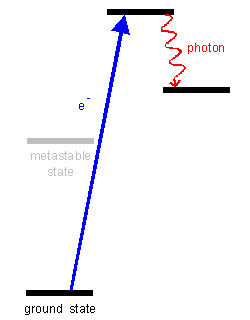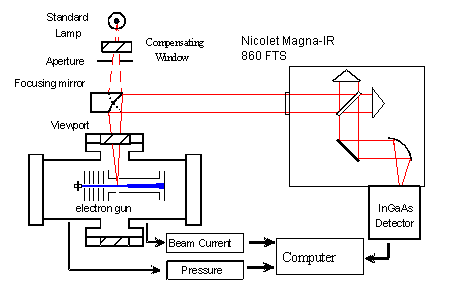Excitation out of the ground state
Fourier Transform Spectometer (FTS) System

Why use a FTS?
As discussed in the section on the near-UV/visible monochromator system, to measure the direct cross section, Qidir, we need to measure not only the apparent cross section Qi, but also all of the optical cross sections that cascade into level-i. As it turns out, for the rare-gases (Ne, Ar, Kr, Xe) many of these cascading levels lie in the infared part of the spectrum.
Photomultipliers (PMT's) do not work well (or at all) much above 1100nm. Photo-diode detectors
(Ge, InGaAs, InSb...) can work in the infared, but have much lower sensitivies than PMTs.
To help compensate for this problem we use the multiplex advantage of Fourier Transform Spectrocopy:
we effectivly measure all the spectral lines simultaneously.
How do we measure the signal?
In this experiment, a variable-energy electron beam passes through a vacuum chamber that has been filled with a few mTorr of the gas of interest. The electron beam excites the atoms into higher levels, and when these levels decay, they emit radiation. This light is directed into a weak-emmission FTS fitted with a IR photodiode. A computer reads the output of the detector and computes the inverse Fourier transform to find the spectrum of the emissions leaving the chamber. The computer also records the chamber pressure and the electron current. From this information we can extract optical cross sections.
Absolute calibration of cross sections:
To place the results on an absolute scale, we need to know two things: the relative response of the optical system (FTS and detector) as a function of wavelength, and the absolute value of one of the optical cross sections. To determine the optical system's wavelength response, we use a standard lamp whose output as a function of wavelength is well known. We use the PMT/Monochromator system to measure the absolute value of one of the optical cross section in the wavelength range in which the two systems overlap (~ 850 to 1100 nm).Some experimental specs:
| Target Density: | 1012 to 1014 atom/cm3 (10-4 to 10-2 Torr) |
| Energy Range: | 0 to 500 eV |
| Electron Beam current: | 150 µA at 100 eV |
| Gases studied: | Helium, Neon, Argon, Krypton, Xenon, Nitrogen |
Recent Published Results
- Cross sections for electron-impact excitation of Krypton
-
J. Ethan Chilton, M. D. Stewart, Jr., and Chun C. Lin,
Phys Rev. A 62 (2000) 032714.
- Electron-impact excitation cross sections of neon
-
J. Ethan Chilton, M. D. Stewart, Jr., and Chun C. Lin,
Phys Rev. A 61 (2000) 052708.
- Measurement of electron-impact excitation into the 3p53d and 3p55s levels of argon using Fourier-transform spectroscopy
-
J. Ethan Chilton, and Chun C. Lin,
Phys Rev. A 60 (1999) 3712-3721.
- Measurement of the cross sections for electron-impact excitation into the 5p56p levels of xenon
-
John T. Fons and Chun C. Lin,
Phys Rev. A 58 (1998) 4603-4615.
- Electron-impact excitation and collisional transfer into the nF levels of helium
-
J. Ethan Chilton and Chun C. Lin,
Phys Rev. A 58 (1998) 4572-4580.
- Measurement of electron-impact excitation into the 3p54p levels of argon using Fourier-transform spectroscopy
- J. Ethan Chilton, John B. Boffard, R. Scott Schappe, and Chun C. Lin, Physical Review A 57 (1998) 267-277.
back to experiments list... back to home page